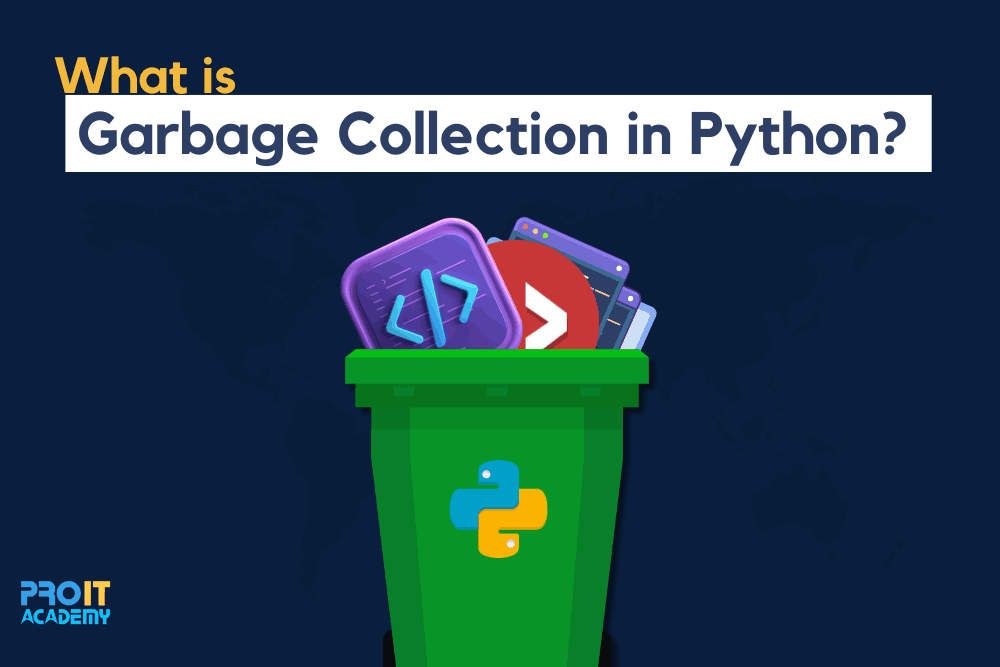Introduction:
Effective memory management must be essential in any programming language. The popular and dynamic language Python offers automatic memory management with the integration of a garbage collector. In this blog post, we will examine the Python concept of garbage collection in great detail.
We will discuss what garbage collection is, how it works in Python, why it matters to developers, and provide practical examples and suggestions on how to manage memory efficiently. Whether you are a new or seasoned Python developer, understanding garbage collection is essential since it may help you optimize your code and building robust applications.
What is Garbage Collection in Python?
Python’s garbage collection plays a crucial role in memory management by identifying and reclaiming objects that are no longer in use. It encourages efficient memory usage by freeing memory from objects the program’s code can no longer access. Python applications are more dependable and perform better due to this automatic memory management, which also relieves developers of the challenges of manually allocating memory.
Reference Counting: The First Line of Defense:
One of the main methods used by Python garbage collection is reference counting. Python objects each have a reference count that maintains track of how many times the object has been referenced. The reference count is increased whenever a new reference to an object is made, and it is decreased whenever a reference is explicitly withdrawn or leaves the scope.
When an object’s reference count reaches zero, it means that there are no longer any references to it, making it suitable for garbage collection. The memory of the object can then be safely deallocated and reclaimed by the garbage collector.
Enhance your Python skills at Python Classes in Pune.
How Garbage Collection Works in Python:
The garbage collector in Python uses a combination of reference counting and cycle detection to manage memory effectively. It utilizes the mark and sweep algorithm to identify and reclaim objects that are no longer in use. The process involves two main phases: marking and sweeping.
During the marking phase, the garbage collector traverses the object graph, starting from known roots, and marks objects that are reachable. In the sweeping phase, the garbage collector reclaims the memory occupied by unmarked objects, making it available for future object allocation.

Garbage Collection Example in Python:
Let’s consider a simple garbage collection in python example. Suppose we have a class called Person with attributes like name and age. If we create multiple Person objects and assign them to variables, the reference count for each object will increase. When these variables go out of scope or are explicitly deleted, the reference count will decrease. Once the reference count drops to zero, the garbage collector will identify the object as garbage and reclaim the memory.
class Person:
def __init__(self, name, age):
self.name = name
self.age = age
# Creating objects and assigning them to variables
person1 = Person(“John”, 25)
person2 = Person(“Alice”, 30)
# Deleting references to objects
del person1
person2 = None
# Garbage collection occurs here
In the example above, when the references to person1 and person2 are deleted or set to None, the reference counts for the Person objects decrease. Once the reference count drops to zero, the garbage collector identifies the objects as garbage and reclaims the memory.
Cyclic References and Cycle Detection:
While reference counting functions effectively in the majority of situations, it fails when there are cyclic references. When a group of objects make circular references to one another, it is impossible to tell which ones are still in use and which ones are not. The garbage collector in Python uses cycle detection algorithms to deal with this problem. Starting from well-known roots, it moves through the object graph, marking reachable objects along the way. After the traversal, unmarked items are regarded as garbage and can be collected. The garbage collector makes sure that memory is efficiently reclaimed even in complicated object interactions by identifying and breaking cycles.

Book Your Time-slot for Counselling !
Generational Garbage Collection:
Python’s garbage collector separates objects into different generations based on their age using the generational garbage collection technique. The three primary generations are commonly referred to as young, middle-aged, and old. Young objects, which are freshly produced, are more likely to become trash shortly than older ones, which have survived multiple waste collection cycles and are more likely to endure. The waste collector concentrates on younger generations and makes more frequent collections for them. This generational strategy optimises the trash collection process while reducing overhead and improving efficiency by focusing on objects that are more likely to have a short lifespan.
Every time you try to add something to a reference counter, it starts a reference loop. The object’s referral counter could never reach zero due to clock cycles. This implies that the object cannot be destroyed by a reference counter. We make use of the universal garbage collector in situations like this. After using memory, it works and frees up the memory. A Generational Garbage Collector is located in the standard library’s GC section.
Tuning Garbage Collection:
Python gives developers the freedom to modify the garbage collector’s behaviour to suit their specific requirements. The gc module provides methods and functions that let the garbage collection process be adjusted. Garbage collection is enabled and disabled, respectively, by the gc.enable() and gc.disable() routines. When manual waste collection control is preferred, this can be handy. Additionally, the gc.collect() function starts a garbage collection cycle right away, giving programmers control over when memory is reclaimed. The ability to modify the garbage collection thresholds, which affects the frequency and aggressivity of trash collection, is made available through the gc.get_threshold() and gc.set_threshold() functions. These tuning options give programmers the ability to tailor memory management to the unique properties and needs of their Python applications.
Memory Management Performance:
Garbage collection can cause some overhead because memory reclamation requires frequent program pauses. Python’s garbage collector has been improved to decrease pauses and boost memory management. Automatic memory management and memory leak prevention typically outweigh the minimal performance impact.
Automatic Memory Management and Garbage Collection
Programmers no longer had to manually manage memory because of automatic memory management. Rather, the runtime handled this on their behalf.
There are several approaches available for memory management that are automatic. The ones in vogue employ reference counting.The runtime uses reference counting to keep track of all the references to an object. The program code cannot use an object and can delete it if there are no references.
For programmers, automatic memory management has various benefits. Developing programs without considering low-level memory specifics is faster. Moreover, it can assist in preventing hazardous hanging pointers and expensive memory leaks.
However, automatic memory management comes with a cost. Its software will need more memory and processing capacity to keep track of every reference.Furthermore, a lot of computer languages with autonomous memory management use a “stop-the-world” approach for garbage collection. Throughout this procedure, the garbage collector locates and eliminates items that require collection, stopping all program execution.
The advantages of autonomous memory management typically exceed the drawbacks, especially in light of Moore’s law and the increased RAM in more recent machines. Thus, most modern computer languages, including Golang, Python, and Java, use automatic memory management.
Specific languages still use manual memory management, particularly for long-running applications where performance is essential. C++ is a prime example of this. The Objective-C programming language, which powers macOS and iOS, also has manual memory management. More modern languages use manual memory management in Rust.
Automatic Garbage Collection of Cycles
Garbage collection must be scheduled since it requires computational work to find reference cycles. Python uses an object allocation and deallocation threshold to determine when to schedule garbage collection. The garbage collector runs when the total number of allocations is less than the total number of deallocations and exceeds the threshold. You can import the gc module and request garbage collection thresholds to examine the threshold for new objects, or what Python refers to as generation 0 objects.
Manual Garbage Collection
When managing memory consumption via reference cycles, manually calling the garbage collector during program execution can be a smart idea.
Time-based and event-based trash collection are the two manual garbage collection methods available.
1. Time-based garbage collection works by simply calling the garbage collector after a predetermined amount of time.
2. Event-based garbage collection notifies the garbage collector when an event takes place. For instance, when the user closes the program or when it goes into idle mode.
Forced Garbage Collection
Python’s garbage collector automatically and regularly gets rid of objects that are no longer being used and are therefore suitable for garbage collection. On the other hand, there are situations when you might wish to make garbage pickup happen right away—using the GC. Collect the () function from the GC module; you may accomplish this.
Disabling Garbage Collection
Python objects can be collected as trash when they are no longer being used. This is done by the garbage collector, which is turned on by default and runs regularly. But sometimes, you should stop the garbage collector from operating; thus, you should disable it. Use the GC. Disable the () function that the GC module provides to accomplish this.
Interacting with Python Garbage Collector
To free up memory and stop memory leaks, Python has a built-in “garbage collector” feature that removes things that are no longer being used. You can talk to garbage collection (GC) in Python in several different ways. The GC module usually runs itself.
1.Turning on and off the garbage collector: The GC. enable() and GC. Disable () methods let you turn the garbage collector on or off, respectively.
2. Forcing garbage collection: The GC.collect() method lets you force garbage collection to happen. This can be useful if you want to have your trash picked up right away instead of waiting for it to occur on its own.
3. Checking the settings for the garbage collector: The GC.get_threshold() method gives you a list of the current thresholds for generations 0, 1, and 2. This lets you check the garbage collector’s settings.
4. Setting garbage collector thresholds:You can set the trash collector thresholds with the GC.set_threshold() function. This enables you to change the limits for each generation by hand, which can change how often garbage is collected.
Impact of Object Size on Garbage Collection:
The size of an object in Python may have an impact on garbage collection. Larger objects use more memory and could take longer to process during garbage collection. As a result, object sizes must be considered, especially when working with huge data structures or resource-demanding applications. To decrease the memory footprint and enhance garbage collection performance, think about optimising data structures or implementing memory-efficient techniques into practise.
Garbage Collection Frequency:
The frequency of garbage collection in Python depends on several factors, including the quantity of newly created objects, the rate at which they are destroyed, and how the programme allocates memory. The Python garbage collector aims to balance memory reclamation with the least amount of performance degradation possible. Garbage collection occurs automatically by default when specific thresholds are achieved. With the help of the gc.set_threshold() function, these thresholds can be adjusted to precisely match the frequency of garbage collection to the specific requirements of the application.
Memory Fragmentation:
Memory fragmentation can occur when memory becomes divided into small, non-contiguous chunks over time. This can lead to inefficient memory utilization and decreased performance. Python’s memory management tools, such as the garbage collector, aid in minimising fragmentation issues. In order to maximise available space, reduce fragmentation, and improve overall memory efficiency, the garbage collector organises the memory.
How to Use the Garbage Collector in Python:
Python provides a module called gc that allows developers to control and monitor the behavior of the garbage collector. Let’s explore some of the functions and methods provided by the gc module:
a) Enabling and Disabling Garbage Collection:
By default, garbage collection is enabled in Python. However, in certain cases, you may want to disable it to optimize performance or debug memory-related issues. The gc.enable() function enables automatic garbage collection if it was previously disabled. Conversely, the gc.disable() function disables garbage collection. Be cautious when disabling garbage collection, as it can lead to memory leaks if not handled carefully.
b) Manually Triggering Garbage Collection:
Python’s garbage collector runs automatically based on certain thresholds and heuristics. However, there may be scenarios where you want to trigger garbage collection explicitly. The gc.collect() function initiates an immediate garbage collection cycle. It attempts to reclaim as much memory as possible by collecting unreachable objects. Manually triggering garbage collection can be useful in situations where memory resources need to be released at a specific point in your code.
c) Configuring Garbage Collection Thresholds:
The gc.get_threshold() and gc.set_threshold() functions allow you to adjust the thresholds that dictate when garbage collection should occur. The thresholds are represented as a tuple of three integers: (threshold0, threshold1, threshold2). These values control the number of allocations that trigger garbage collection. By fine-tuning these thresholds, you can control the frequency of garbage collection cycles. However, be cautious when modifying these thresholds, as improper settings can impact memory utilization and performance.
d) Debugging and Monitoring:
The gc module provides additional functions to aid in debugging and monitoring garbage collection. For instance, gc.set_debug() enables debug output, providing detailed information about the garbage collection process. This can help identify potential issues related to memory management and object references. The gc.get_stats() function returns statistics about the garbage collector’s activity, including the number of objects tracked, the number of collections performed, and the amount of memory reclaimed.
e) Context Managers for Garbage Collection:
Python’s gc module also supports context managers to temporarily modify the behavior of the garbage collector within a specific block of code. By utilizing the gc.isenabled() function in conjunction with the contextlib module, you can create a context manager that temporarily enables or disables garbage collection within a specific code block. This can be useful in scenarios where you want fine-grained control over when garbage collection is active.
By utilizing these features provided by the gc module, you can customize the behavior of the garbage collector in Python to suit your specific requirements. However, it’s important to note that in most cases, the default garbage collection settings are sufficient for typical Python applications.

Do you need help to create your career path ?
Garbage Collection in Performance-Critical Scenarios:
The garbage collector’s default behaviour might not be the best choice in situations when performance is crucial, like real-time systems or high-performance computing. Alternative memory management techniques or specialised libraries may be used in such circumstances. For instance, certain performance-focxd Python frameworks offer specialised memory management features that enable programmers to precisely control memory allocation and deallocation to satisfy particular performance demands.
a) Avoiding Memory Leaks:
Python’s garbage collector helps to minimise memory leaks, although in some circumstances memory leaks can still be unintentionally created. When references to things are unintentionally left around for longer than necessary, this happens frequently. For example, by failing to remove references to objects kept in global variables or class attributes, their garbage collection may be halted. When references to objects are no longer required, they should be released or removed in order to prevent memory leaks.
b) Manual Memory Management with the ctypes Module:
Often Python programmers have to deal with low-level code that requires manual memory management or use third-party libraries. The ctypes module in Python provides a way to communicate with C applications and manually manage memory. The ctypes module gives developers extra flexibility over memory management by allowing them to manually allocate and deallocate memory as needed. However, manual memory management should be used with caution because it increases the risk of memory leaks and is prone to error.
c) Memory Profiling Tools:
Python provides a number of memory profiling tools to further examine memory utilisation and spot potential memory-related problems. Developers can profile memory consumption, track object allocations and deallocations, and find memory leaks using tools like memory_profiler and objgraph. These tools offer insightful information about memory usage trends and might point out places where memory management in Python programs needs to be improved.
d) Garbage Collection and Multithreading:
When working with multithreaded Python applications, garbage collection must be taken into consideration. Python’s garbage collector uses a Global Interpreter Lock (GIL) by default to preserve thread safety. This proves that Python bytecode execution, including garbage collection, may occur in a single thread. Although the GIL ensures thread safety, it can occasionally limit the performance benefits of parallelism. It’s essential to understand how garbage collection, the GIL, and multithreading interact when developing and optimising multithreaded Python applications.

Garbage Collection in Python Libraries:
In addition to the core Python language, various libraries and frameworks leverage garbage collection to manage memory efficiently. Let’s explore some examples:
a) NumPy: One of the most important Python libraries for scientific computing is NumPy. The ability to handle large arrays and conduct computations strongly relies on effective memory management. For memory management, NumPy combines reference counting and garbage collection techniques. In order to limit needless memory allocation and deallocation, the library offers features like array views and in-place operations.
b) Pandas: A well-liked Python data manipulation library is Pandas. For effective data analysis, it offers strong data structures like DataFrames. When working with huge datasets, Pandas uses garbage collection strategies to manage memory. It uses techniques like object pooling and memory layout optimisation to reduce memory utilisation and boost speed.
c) Django: Django is a well-liked web framework for Python. Web applications manage memory using garbage collection mechanisms. The Django framework uses garbage collection to offer complete cleanup while controlling object lifecycles. Furthermore, it provides features like connection pooling to optimise database operations and minimise memory utilisation.
d) TensorFlow: An open-source machine learning library called TensorFlow depends on effective memory management. It handles memory deallocation for tensors and other objects used in machine learning processes via garbage collection. TensorFlow uses a variety of techniques, like as memory pooling and object reuse, to optimise memory utilisation and boost speed when performing difficult computational tasks.
e) SQLAlchemy: SQLAlchemy is a well-known Python object-relational mapping (ORM) framework. It makes use of garbage collection technologies to efficiently manage database connections and resources. In order to ensure thorough cleanup and minimise resource wastage, SQLAlchemy uses technologies like connection pooling and context management when handling resource allocation and deallocation.
Advantages and Disadvantages
Let’s look at some of the pros and cons of Python’s trash collection.
Advantages:
- Automated memory management: The Python garbage collector removes things that are no longer being used. This reduces the possibility of running out of memory and stops memory leaks.
- Memory management simplification: By eliminating the need for developers to manage memory manually, the garbage collector enables them to focus on code creation, thereby elevating Python to a more pragmatic and high-level programming language.
- Effective memory cleanup: The garbage collector is made to impact speed as little as possible while quickly finding and collecting objects that don’t need to be kept around. This is done through generational garbage collection.
- Allows customization: The garbage collector lets you change some of its settings, like the thresholds for different generations. Because of this, developers can adjust the garbage collection procedure to better suit the requirements of their particular applications.
Disadvantages:
- Effects on performance: The garbage collection is meant to get rid of unused memory quickly, but it may still use more CPU time and take longer to run, especially when there are a lot of objects to deal with.
- The difficulty of handling memory: You can use Python’s garbage collector to make handling memory easier, but to do it right, you may still need to know about object lifetimes, object references, and garbage collection algorithms.
- Limited control over memory management: Because garbage collection works independently, developers have little say over when and how memory is cleaned up. This might not be ideal for many situations where fine-grained control over memory management is needed.
- Potential bugs: The garbage collection is meant to be reliable and effective, but it can make mistakes or act in ways that aren’t normal. This could lead to memory leaks or bad object cleanup.
The Future of Garbage Collection in Python:
Python is always developing, and new ways to make its garbage collection mechanism better are always being considered. The Python community is continually developing tools for better memory profiling and analysis as well as improvements to memory management and garbage collection methods. Developers should anticipate future advancements in Python’s garbage collection performance, memory usage, and general memory management efficiency. To learn Python from experts ProIT Academy will be the best institute for you.
Conclusion:
Garbage collection, which frees developers from having to manually deallocate memory and allows them to focus on writing code, is a crucial part of Python’s memory management system. By utilising reference counting and cycle detection, the garbage collector in Python effectively manages memory and releases objects that are no longer in use. By understanding the principles and behaviour of garbage collection, developers can optimise memory usage, prevent memory leaks, and produce reliable Python applications. By combining Python’s built-in garbage collector with best practises in memory management, developers may take advantage of Python’s capabilities while ensuring perfect memory usage and performance.












